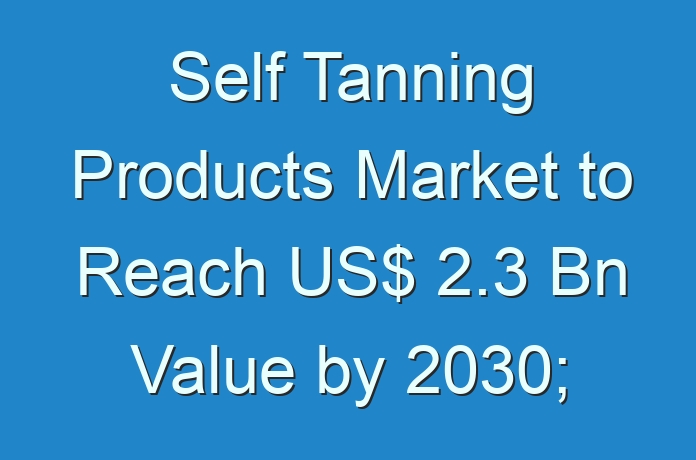
Demand for Safe, Healthy, and Natural Self-tanning Products on Rise
The self-tanning products market has witnessed a steady growth in the past decade. Although the global sales of self-tanning products were sluggish in the initial phases due to uncertainty among consumers regarding ingredients, safety, and negative effects of using self-tanning products. The demand for self-tanning products has witnessed consistent growth in the past few years, owing to a range of factors. One of the major factors expected to drive the sales of self-tanning products is the growing evidence and mounting concerns pertaining to the harmful effects of sun tanning on the skin.
The wellness industry is gradually adapting to evolving consumer choices and increasingly turning to natural ingredients to develop self-tanning products. At present, market players are expected to focus on the production of products that offer a natural tan to increase their brand credibility and value. In addition, several leading players in the global self-tanning products market are likely to expand their product portfolio to increase their presence in the market. While regulatory bodies around the world have laid down a solid framework pertaining to the production and marketing of self-tanning products, brands are expected to work toward gaining approval for their products.
At the back of these factors, along with the evolving consumer and regulatory landscape, the global self-tanning products market is expected to cross US$ 2.3 Bn mark by the end of 2030.
Want to know the obstructions to your company’s growth in future? Request a brochure @ https://www.transparencymarketresearch.com/sample/sample.php?flag=S&rep_id=38216
Consumers Leaning Toward UV-free Tan Alternatives amid Reports of Skin Cancer
Over the past few years, consumer trends indicate a tectonic shift away from natural tanning, especially in regions wherein ozone depletion is a major concern. Consumer awareness pertaining to the harmful effects of the sun in certain regions and the growing number of skin cancer cases in regions with high ozone depletion, including Australia, are some of the key factors that have generated considerable interest in self-tanning products. Consumer trends in multiple regions suggest a growing demand for UV-free tan products– a factor that is expected to contribute to the growth of the self-tanning products market in the upcoming years. The growing desire to attain a fashionable and glowing tan, especially in young adults is a major trend that is anticipated to provide boost to the sales of self-tanning products during the assessment period.
The demand for self-tanning products is on the rise, particularly in developed regions, including North America and Europe. Some of the most common self-tanning products that are in demand include body tanner, skin tanner, and face tanner. The increasing documentation of the negative effects of sunlight and UV radiation on the human skin is projected to drive the demand for UV-free tan alternatives.
Market Players Focus on Expanding Product Range to Gain Advantage
Due to increasing awareness and scientific evidence pertaining to the ill-effects of UV radiation, the demand for self-tanning products has consistently moved in the upward trajectory. Sensing the growing interest in self-tanning products, market players are increasingly investing resources on research & development and diversifying their product portfolio. Several self-tanning products market market players are launching new products and expanding their product portfolio to increase their market share and presence. For instance, in February 2019, Tournesol ™ announced the launch of its inaugural range of self-tanning products. Moreover, in January 2017, Bondi Sands announced the launch of an ultra-dark self-tanning foam and expanded its product portfolio. In January 2018, Sienna X launched three new self-tanning products that were previously available only at salons.
Launch of new products, changes in the product development process, and use of natural and green ingredients are trends within the self-tanning products market.
Looking for exclusive market insights from business experts? Request a Custom Report
Demand for Self-tanning Products to Decline during COVID-19 Pandemic
The COVID-19 pandemic is expected to have a strong impact on the growth of the self-tanning products market especially in 2024. Self-tanning products are not classified as essential products by governments in several nations due to which, the production as well as its demand have taken a major hit. Services in the tanning salon industry are expected to witness a massive setback due to the ongoing COVID-19 pandemic and declining demand. However, as governments are expected to increase spending and gradually allow businesses to reopen post a brief period of lockdown, the market is expected to show signs of improvement in the upcoming months. As spas, salons, and other players in the beauty industry are anticipated to gradually resume services, the demand for self-tanning products is expected to grow toward the last quarter of 2024.
Read Our Trending Press Release Below: https://www.prnewswire.co.uk/news-releases/rising-number-of-do-it-yourself-customers-fuels-expansion-of-e-commerce-automotive-aftermarket-market-tmr-884599179.html





